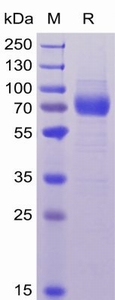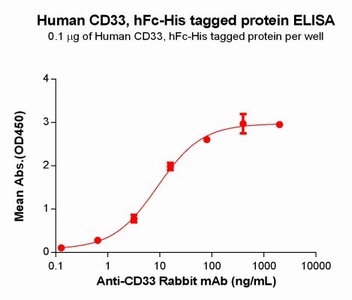| 目录: 11166 |
| 产品名称: Human CD33(18-259) Protein |
| 规格: 10 µg, 50 µg and 100 µg |
| 基因符号: CD33;IGLEC3;p67 |
| Target: CD33 |
| UNIPROT ID: P20138 |
| 描述: Recombinant human CD33 protein with C-terminal human Fc and 6xHis tag |
| 背景: Sialic-acid-binding immunoglobulin-like lectin (Siglec) that plays a role in mediating cell-cell interactions and in maintaining immune cells in a resting state. Preferentially recognizes and binds alpha-2,3- and more avidly alpha-2,6-linked sialic acid-bearing glycans. Upon engagement of ligands such as C1q or syalylated glycoproteins, two immunoreceptor tyrosine-based inhibitory motifs (ITIMs) located in CD33 cytoplasmic tail are phosphorylated by Src-like kinases such as LCK. These phosphorylations provide docking sites for the recruitment and activation of protein-tyrosine phosphatases PTPN6/SHP-1 and PTPN11/SHP-2. In turn, these phosphatases regulate downstream pathways through dephosphorylation of signaling molecules. One of the repressive effect of CD33 on monocyte activation requires phosphoinositide 3-kinase/PI3K. |
| Species/Host: HEK293 |
| Molecular Weight: The protein has a predicted molecular mass of 53.8 kDa after removal of the signal peptide. |
| Molecular Characterization: CD33(Asp18-His259) hFc(Glu99-Ala330) 6×His tag |
| 纯化:: The purity of the protein is greater than 95% as determined by SDS-PAGE and Coomassie blue staining. |
| Formulation & Reconstitution: Lyophilized from nanodisc solubilization buffer (20 mM Tris-HCl, 150 mM NaCl, pH 8.0). Normally 5% – 8% trehalose is added as protectants before lyophilization. |
| 储存和运输: Store at -20°C to -80°C for 12 months in lyophilized form. After reconstitution, if not intended for use within a month, aliquot and store at -80°C (Avoid repeated freezing and thawing). Lyophilized proteins are shipped at ambient temperature. |

Figure 1. Human CD33, hFc-His Tag on SDS-PAGE under reducing condition. | 
Figure 2. ELISA plate pre-coated by 1 µg/ml (100 µl/well) Human CD33(18-259) Protein, hFc-His Tag(11166) can bind CD33 Rabbit mAb in a linear range of 3.2-16 ng/mL. |
|












